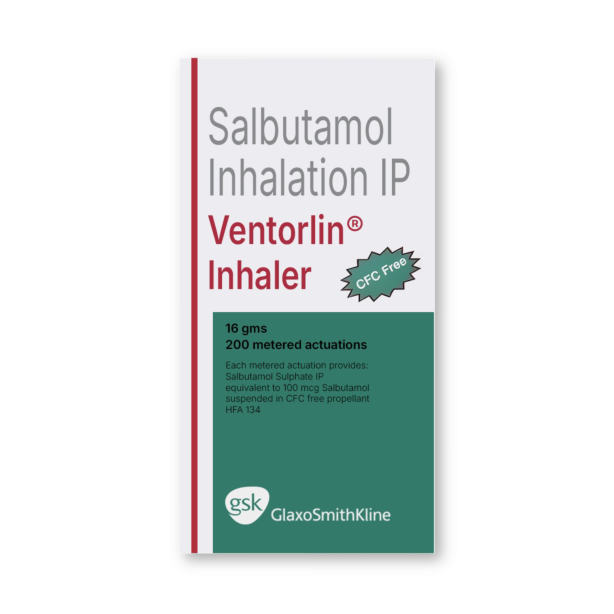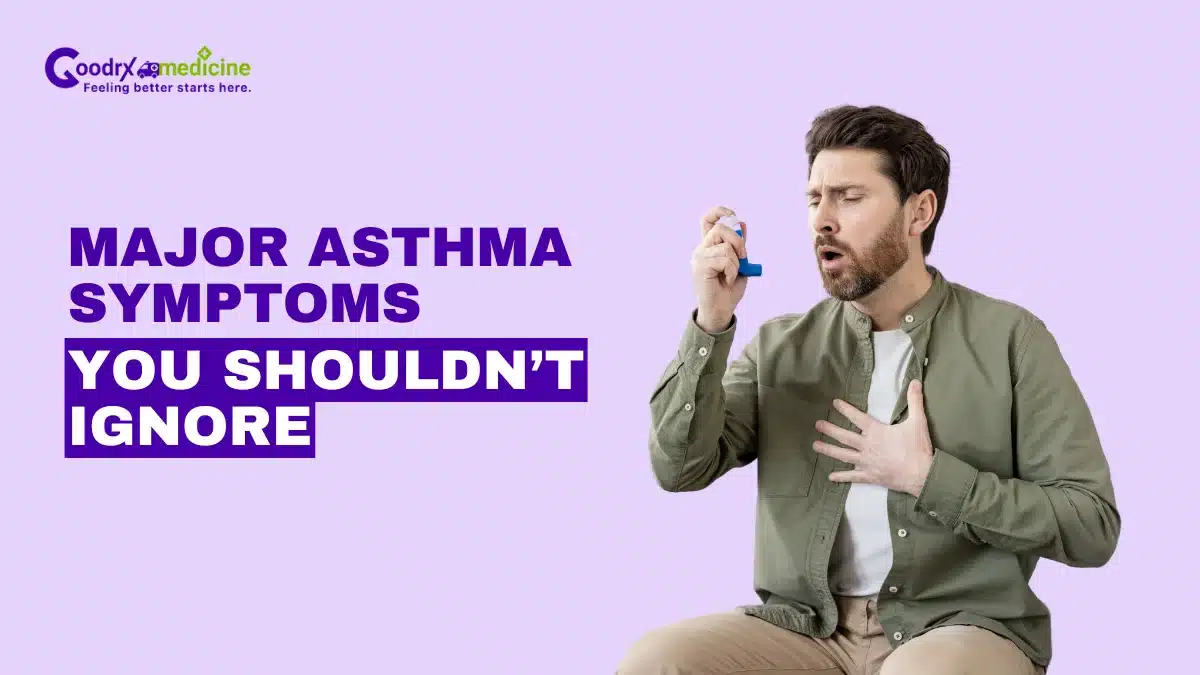Breathing is something we often take for granted and rarely think twice about—until we have a condition that makes breathing a daily challenge. One such condition that severely impacts one’s ability to breathe is Asthma. It is a chronic (long-term) disease that narrows one’s airways and causes difficulty breathing.
Among the many respiratory conditions, Asthma is particularly widespread. It affects over 28 million people in the US alone.
These statistics are concerning, and it is important to recognize Asthma symptoms early. Early detection can lead to better management, proper diagnosis, and timely treatment of the condition, preventing its negative consequences.
In this article, we’ll explore various symptoms of Asthma, how they can affect your daily life, what typically triggers them, and when seeking medical attention is essential. So, let’s learn in detail.
Common Asthma symptoms
When discussing Asthma, coughing and breathlessness can be the first symptoms that come to your mind. However, symptoms of Asthma can vary widely among individuals and may change over time.
For some, it may mean occasional shortness of breath or wheezing; for others, it can involve frequent flare-ups that disrupt daily activities, sleep, and overall well-being. Thus, it highlights the need for proper Asthma medications.
Some of the most common signs and symptoms of Asthma are as follows:
- Shortness of breath: Breathing difficulty or feeling is one of the main symptoms people often report.
- Wheezing: You may observe a high-pitched whistling sound when exhaling.
- Coughing: A dry and persistent cough, often experienced at night, during exercise, or when laughing.
- Chest tightness or pain: You may experience a sensation of chest tightness or discomfort.
- Rapid breathing: Breathing becomes faster than normal, sometimes accompanied by difficulty in speaking.
- Trouble sleeping: If you have persistent coughing, wheezing, or shortness of breath, you may experience difficulty sleeping.
These symptoms may be mild, lasting only a few minutes, while severe episodes can persist for hours or even days.
Save up to 90% on your medicine bills

Aerocort Inhaler 50 mcg + 50 mcg

Bolstran 150 mg Injection

Ventorlin CFC Free Inhaler 100 mcg/18 mg

Asthalin HFA Inhaler 100 mcg
Asthma attack symptoms
Recognizing early signs can help prevent a full-blown Asthma attack. These early symptoms often precede more severe breathing difficulties and include:
- Frequent coughing, especially at night
- Shortness of breath or difficulty breathing easily
- Wheezing or coughing after exercise
- Feeling tired, weak, or unusually irritable
- Changes in lung function
- Sweating
- Signs of a cold or allergies, such as sneezing or nasal congestion
- Trouble sleeping due to respiratory symptoms
Childhood Asthma symptoms
Children often show Asthma symptoms as their airways make them more susceptible to inflammation and narrowing.
Some common symptoms in children include:
- Wheezing
- Frequent coughing, especially at night or during viral infections
- Shortness of breath and chest tightness
- Trouble sleeping due to coughing or wheezing
- Fatigue from poor sleep or difficulty breathing during play and exercise
In young children, symptoms can sometimes be mistaken for other respiratory conditions, like frequent colds. Persistent or recurrent symptoms should be promptly evaluated for Asthma.
Adults with Asthma typically experience symptoms similar to those of children. However, some adults develop the condition later in life (adult-onset Asthma).
Different factors, such as occupational exposures or hormonal changes, can trigger the symptoms in these cases. Older adults may also experience more severe symptoms due to age-related lung function changes and other health conditions.
Symptoms of Asthma subtypes
The variations in symptoms based on various types of Asthma are as follows:
Eosinophilic Asthma symptoms
Eosinophilic Asthma is characterized by high Eosinophil levels. These cells are the type of White Blood Cell (WBC) involved in immune responses. It causes inflammation throughout the respiratory system, from the nasal passages to the smallest airways in the lungs.
Some common symptoms of Eosinophilic Asthma, different from common symptoms, are as follows:
- Obstructed airflow due to airway inflammation and mucus buildup
- Stuffy nose, nasal drainage, and chronic sinus infections
- Loss of sense of smell (Anosmia)
- Nasal polyps
Allergic Asthma symptoms
Allergy-induced Asthma is the most common Asthma subtype. It is triggered by inhaling allergens such as pollen, dust mites, animal dander, or mold spores. The symptoms arise specifically after exposure to allergens, and the immune system’s response causes airway inflammation and tightening.
In addition to the common symptoms, some distinct symptoms of this Asthma subtype include allergy signs such as red, itchy, or watery eyes, sneezing, stuffy or itchy nose, and occasionally, skin rashes.
Non-allergic Asthma
Non-allergic Asthma presents symptoms similar to Allergic Asthma but is not triggered by allergens. Symptoms are similar to the common symptoms of Asthma, such as wheezing, coughing, and chest tightness.
Triggers for non-allergic Asthma include viral respiratory infections, irritants or pollution, stress, certain medications, food additives, and extreme weather conditions.
Exercise-induced Asthma symptoms
Exercise-induced Asthma (also called Exercise-induced Bronchoconstriction) occurs when physical activity narrows airways, leading to symptoms of Asthma during or shortly after exercise.
Symptoms typically start during or soon after exercise, and some symptoms include:
- Coughing
- Wheezing
- Shortness of breath
- Chest tightness or pain
- Fatigue during exercise
- Poor athletic performance compared to usual levels
- Avoidance of physical activity, especially in children
If untreated, symptoms may last an hour or more and sometimes recur hours after exercise (late-phase symptoms). Cold, dry air, pollution, and high pollen counts can worsen symptoms. Though common in people with Asthma, Exercise-induced Asthma can also affect individuals without a formal Asthma diagnosis.
Severe Asthma symptoms and emergency signs
Severe Asthma can be life-threatening, often requiring immediate medical attention. Signs of a severe Asthma emergency are as follows:
- Rapid worsening of shortness of breath
- No improvement after using a quick-relief inhaler
- Shortness of breath during minimal physical activity
- Severe wheezing when breathing both in and out
- Persistent coughing that does not stop
- Chest pain or pressure
- Using the neck and chest muscles to breathe
- Difficulty talking or feelings of panic
- Pale, sweaty face or bluish lips and fingernails (Cyanosis)
How do Asthma symptoms affect your daily life?
Asthma can significantly affect the quality of your life. Frequent coughing, wheezing, and breathlessness can interfere with sleep, physical activity, and work performance.
Uncontrolled Asthma in children may lead to missed school days and limitations in play and sports. Adults may experience fatigue and reduced productivity. Proper symptom control helps maintain normal daily activities and prevents long-term lung damage.
When to seek medical help?
It is essential to understand when you need to seek medical help. Consult your doctor immediately in the following cases:
- If you suspect you have Asthma or experience frequent coughing, wheezing, or shortness of breath lasting more than a few days.
- If you already have Asthma, consult your doctor regularly to monitor and manage your symptoms effectively.
- If your symptoms worsen or you need to use your quick-relief inhaler more frequently than usual.
- Lips or fingernails turning blue or gray (cyanosis), indicating insufficient oxygen.
- Feeling confused, agitated, exhausted, or unable to concentrate due to breathlessness.
Conclusion
Asthma is a chronic respiratory condition that narrows the airways and affects breathing. Symptoms can vary based on age, subtypes, and severity. Some of the most common Asthma symptoms include cough, wheezing, shortness of breath, and chest-tightening-like symptoms.
While the condition is common, it may cause occasional symptoms, such as shortness of breath and frequent severe flare-ups. Some external or internal factors, such as allergens, exercise, weather, stress, and medications, can also trigger an Asthma attack.
Therefore, it is essential to consult your doctor and detect the triggers of your symptoms early. Seek medical help if you experience frequent difficulty breathing, already have Asthma, have turned your lips or fingernails blue, or find it difficult to concentrate.

Frequently Asked Questions
Is gagging a symptom of Asthma?
Gagging is not a direct symptom of Asthma. However, Asthma-related throat irritation, severe coughing, or acid reflux (which is common in people with Asthma) can trigger a gagging reflex. A doctor should evaluate persistent throat tightness or gagging to rule out other causes or complications.
How to reduce Asthma symptoms without an inhaler?
To reduce symptoms of Asthma without an inhaler, avoid triggers, practice deep breathing exercises, stay hydrated, use a humidifier, and maintain good air quality. Manage stress and follow a healthy lifestyle, but consult a doctor for proper Asthma management.
Does coffee help Asthma symptoms?
Yes, coffee may temporarily help with symptoms of Asthma because caffeine acts as a mild bronchodilator, improving lung function. However, it is not a substitute for Asthma medication and should not replace prescribed inhalers or treatments.
Are Asthma symptoms worse at night?
Yes, Asthma often worsen at night due to natural airway inflammation, lower hormone levels, and triggers like allergens or cold air. This can cause coughing, wheezing, and shortness of breath, disrupting sleep and indicating poorly controlled Asthma.
Can acid reflux cause Asthma-like symptoms?
Yes, acid reflux can cause Asthma-like symptoms by irritating the airways, leading to coughing, wheezing, chest tightness, and shortness of breath. This irritation can worsen Asthma or mimic its symptoms, making reflux a common trigger for respiratory issues.
When referencing outside resources, GoodrxMedicine always provides full citations. To learn more about the measures we use to maintain the quality of our content, please review our Content Information Policy.











